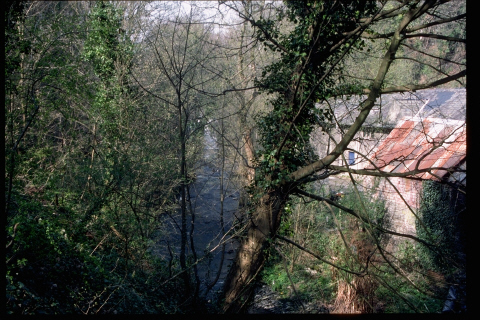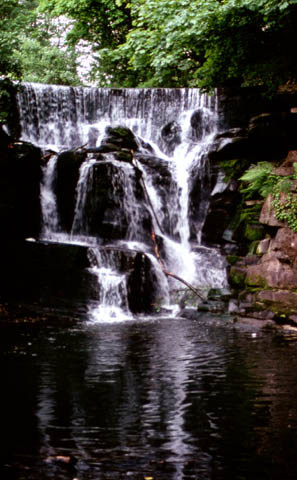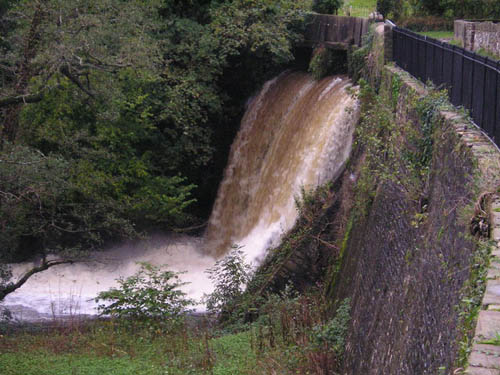
As we continue along the road, notice the rounded, black stones atop the dry stone wall. Look carefully and you can see patterns where the stone has flowed, for these are cast slag from the copperworks (see later).
We come to what was last century a traditional woollen
mill, and the mill building still exists today, being used by the firm of Histon
Overalls and being supported by the massive pillars cast at Neath Abbey Ironworks.
Initially the woollen mill was powered by an enormous, twenty ton water-wheel
and later by a water turbine. Engines were next substituted to avoid problems
in a drought and, later still, electric motors in 1945. Just below the waterfall
of the river Clydach a forge and rolling mill had been constructed by Neath
Abbey Ironworks in 1825, using a water-wheel for power, and in 1870 the forge
was converted to a textile mill. This woollen mill was the oldest in Glamorgan
at the time it closed in 1974. It produced check blankets, tweeds, travelling
rugs, Welsh shawls, socks, stockings, knitting wools and commission spinning.
Its machinery was eventually bought by Swansea Council and installed in 1974
in Swansea Industrial Museum. It later moved to the
National Wool Museum at Drefach Felindre, near Newcastle Emlyn, Cardiganshire,
where it is still working today.
 |
The woollen mill, clinging to
the side of the valley, barely visible through the trees on the opposite
bank of the river. The falls are just visible (centre) through
the trees. |
 |
The falls alongside the Factory. |
A dam had been constructed in 1840 in the valley of Cwmfelin to provide a continuity of water supply for the water-wheels of the Abbey Ironworks, and below this dam the river Clydach tumbles over the falls just above the site of the foundry and woollen mill. The Cwm Clydach (or Dyffryn) pond is still there today, though it's water level is considerably reduced, and the pond is much silted up.

The dam and overflow from the pond after heavy rain.
( Picture
by
Gareth Davies from Geograph
/
CC BY-SA
2.0)
Modern aerial views of the pond can be seen on Coflein.

The pond today
The dam collapsed in 1929 after heavy rain. The Times reproduced on 20 November an article from The Cambrian newspaper:
FLOODS IN WALES
Large areas in South Wales have again been flooded
by heavy rains, the most seriously affected districts being the Rhondda
Valley and Neath district.
.... Several houses were flooded out at Aberdulais, Resolven and Neath Abbey.
At the last place the position is especially serious. a large lake on the
Duffryn estate burst its banks. A sluice which takes the water from it into
the Cwmfelin stream was inadequate to cope with the tremendous flow of water,
with the result that a dam 60ft. in extent collapsed and thousands of gallons
of water poured into the valley, sweeping everything before it in its course
towards Neath Abbey. The flannel factory about 300 or 400 yards below the
dam was flooded and considerably damaged, and 15 houses were completely
flooded out, five of them having water up to the bedrooms. The occupants
were taken unawares while in bed and were unable to leave their rooms, several
having to be rescued with ropes and planks.
Near Cwm Clydach pond, we can see a fine old mansion, Glynfelin House, once owned by the Gibbins family.